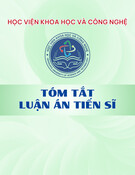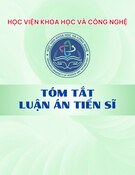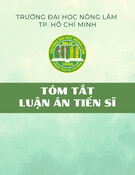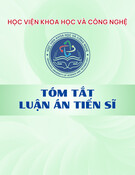
MINISTRY OF EDUCATION AND
TRAINING
VIETNAM ACADEMY OF SCIENCE
AND TECHNOLOGY
GRADUATE UNIVERSITY OF SCIENCE AND TECHNOLOGY
**********************
PHAM THANH NGA
INHIBITORY EFFECT OF EUPATORIUM FORTUNEI
TURCZ. EXTRACTS ON THE GROWTH OF A TOXIC CYANOBACTERIAL SPECIES Microcystis aeruginosa IN
FRESH WATERBODIES
Major: Environmental Engineering
Code: 9.52.03.20
SUMMARY OF DOCTORAL THESIS IN ENVIRONMENTAL
ENGINEERING
Hanoi - 2019

The doctoral thesis was completed at Institute of Environmental Technology (IET),
Graduate University of Science and Technology, Vietnam Academy
of Science and Technology
Supervisors:
Prof. Dr. Dang Dinh Kim
Dr. Le Thi Phuong Quynh
Reviewer
1.
Reviewer
2.
Reviewer
3.
This doctoral thesis will be defended at Graduate University of
Science and Technology, Vietnam Academy of Science and Technology at …… on ……
2019
This doctoral thesis can be found at:
Library of the Graduate University of Science and Technology, VAST.

1
INTRODUCTION
1. NECESSITY OF DOCTORAL THESIS
Eutrophication is a widespread problem in aquatic ecosystems around the world due to sewage
and surface run-off. It significantly affects water quality and induces off-flavor problem. Moreover,
cyanobacterial blooms usually break out along with release of cyanotoxins, which cause a series of
adverse effects such as decreasing water quality and biodiversity, and illness in animals and humans.
Among all sorts of microalgae, Microcystis aeruginosa, one of the most common representative species
responsible for the water blooming, can produce hepatotoxins and neurotoxins which may lead to
headache, fever, abdominal pain, nausea, vomiting and even cancer. Therefore, it is of great importance
to inhibit the growth of cyanobacteria, especially M. aeruginosa in eutrophic waters. Basically, there
are three short-term approaches to control harmful algal blooms such as chemical, physical and
biological approaches. Chemical treatments can effectively and rapidly remove algal bloom. However,
some algicidal chemicals can cause secondary pollution of aquatic environment or persistence in the
environment and the inhibitory effects of most chemicals do not selectively target harmful
cyanobacteria; leading to the collapse of aquatic ecosystems. Physical methods like mixing lake water
using an air compressor, pressure devices or ultraviolet irradiation indicate less subsequent secondary
pollution. However, the disadvantages of physical treatments of algal removal are energy intensive and
tend to be low efficiency as well as injury to non-target species. In recent years, biological methods
including using algicidal bacteria have received much more attention as alternatives to chemical agents.
These approaches tend to be environmental friendly and promising methods for controlling toxic
cyanobacteria. However, the efficiency of biological method is influenced by many biotic and abiotic
factors in the environment. For these limitations of the above approaches, the discovery and use of
natural compounds that feature selective toxicity towards phytoplankton communities and are nontoxic
to other aquatic species, have been a significant advance in the management of aquatic ecosystems.
Eupatorium fortunei Turcz, a species of Asteraceae, is a perennial herb used in folk medicine as a
medicinal and has been demonstrated antibacterial activity in various scientific studies. In 2008, Nguyen
Tien Dat and et al carried out the experiments of using plant extracts to inhibit the growth of M.
aeruginosa. The results showed that the extract from E. fortunei indicated the highest inhibitory effect
on the species. This conclusion was confirmed by the publication of Pham Thanh Nga in the following
years. However, these are only preliminary studies investigating the using of the plant extract to control
toxic cyanobacterial bloom.
By wishing to inherit, develop previous research results and solve several reaserch questions
related to the issue, author chose topic: “Inhibitory effect of Eupatorium fortunei Turcz. extracts on
the growth of a toxic cyanobacterial species Microcystis aeruginosa Kützing in fresh waterbodies”
2. RESEARCH PROPOSE OF THE DOCTORAL THESIS
Research to create effective plant extracts from E. fortunei to inhibit growth of Microcystis aeruginosa
Kützing in the laboratory and outdoor larger scale.
3. TASKS OF THE DOCTORAL THESIS
- Develop the process of producing crude extracts, fractions and pure chemical compounds isolated from E.
fortunei
- Study of inhibitory effect of the crude ethanol extracts from E. fortunei on the growth of M.aeruginosa
and evaluating their ecological safety to non-target aquatic organisms.
- Study of inhibitory effect of the fraction extracts from E. fortunei on the growth of M. aeruginosa and
evaluating their ecological safety to non-target aquatic organisms.
- Study of bioactive properties of chemical compounds isolated from E. fortunei.
- Research on the application of plant extracts to control cyanobacterial bloom in natural water samples (in
the laboratory and outdoor scales)
4. METHODOLOGY OF RESEARCH
The author uses different modern research methods which provide the scientific reliable results and
suitable to Vietnam's conditions. The methods include 1). Methods of plant sample treatment, production of
plant extraction and isolation of pure chemical compounds; 2). Method of identifying the chemical structure
of pure compounds (1H, 13C-NMR, DEPT, HMBC, HR- ESI-MS); 3). Methods of evaluating the growth of
cyanobacterial M. aeruginosa, Ch. vulgaris and phytoplanktons; 4). Method of evaluating the toxicity of plant
extracts to non-target aquatic organisms (Daphnia magna and Lemna minor); 5). Morphology of M.

2
aeruginosa and Ch. vulgaris under the exposure of plant extracts (TEM); 6). Standard methods in water
analysis (physical and chemical parameters).
5. SCIENTIFIC AND PRACTICAL MEANINGs OF THE DOCTORAL THESIS
Water pollution, especially the eutrophication that caused the cyanobacterial bloom including
mainly M. aeruginosa which releases microcystin toxins, has received much attention and research in
recent times. Using plant extracts to control this phenomenon indicates more advantages than other
traditional methods used previously. The results of the doctoral thesis provide a scientific basis of the
feasibility of using plant extracts as a selective inhibitor to the growth of M. aeruginosa in order to control
the toxic cyanobacterial bloom while do not harm to other non-target organisms in aquatic ecosystems.
6. NEW CONTRIBUTION OF THE DOCTORAL THESIS
- Isolation of 02 pure new chemical compounds from Eupatorium fortunei which have not been
published in international scientific journals. Investigation of the biological activity of these compounds to
control M. aeruginosa at the concentrations from 1.0 µg.mL-1 to 50 µg.mL-1. Growth inhibitory effect (IE) was
recorded from 10 to 45% after 72 hours of exposure.
- Application of the innovative method to control the growth of toxic microalga (M. aeruginosa) by
using extracts from Eupatorium fortunei Turcz. The experiment was carried out from the laboratory scale in
150- mL flashes with IE of over 90%, then in the 5L aquarium and in the outdoor scale (3 m3) with IE around
of 60 % for evaluating the different efficiency between the theoretical value and practical application. The
ethanol extract proved to be more toxic to M. aeruginosa than to Daphnia magna and Lemna minor.
7. STUCTURE OF THE THESIS
The thesis is organized in the introduction, three chapters and concluding section with 143 pages, 18
tables and 45 figures and graphs. The thesis uses 182 references with more than 40% of the papers published
in the last five years (from 2013 to 2018). Chapter 1 presents an overview about researches related to
eutrophication and the toxic cyanobacterial bloom in aquatic ecosystem and the methods used to control these
problems. Chapter 2 presents research objectives, methods and the design of experiments. Chapter 3 shows the
reaserch results and gives discussion. The chapter 3 will be presented in more detail in the next section.

3
CHAPTER 3. RESULTS AND DISCUSSION
3.1. The process of producing crude extracts, fractions and pure chemical compounds
isolated from E. fortunei Turcz.
Table 3.1. Effeciency of crude extract production in various solvents
Solvent
Gram crude plant extract/100gram
dried materials
Ethanol
9.17
Methanol
12.75
W (Water)
8.75
Table 3.2. Effeciency of fraction production from crude ethanol extracts of E. fortunei
Fractions
Gram fractions/100 gram crude ethanol
extract (%)
n-hexan
18.97
EtOAc
10.57
W
60.27
Table3.3. Effeciency of isolating 7 chemical compounds from E. fortunei
Compounds
Mg compound/100 g EtOAc fractions of E.
fortunei.
1.
EfD5.1
71.69
2.
EfD14.1
20.80
3.
EfD1.8
13.34
4.
EfD10.1
4.56
5.
EfD10.3
3.91
6.
EfD4.7
2.61
7.
EfD4.8
1.56


























